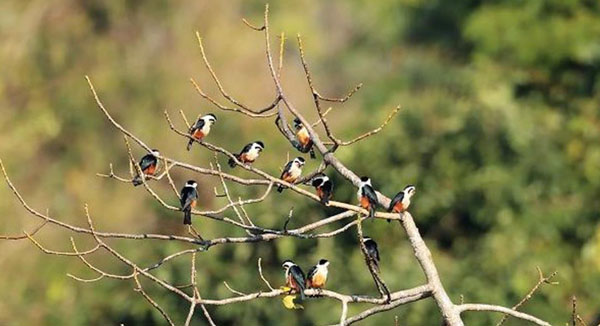Microhierax caerulescens
IUCN
LCBasic Information
Scientific classification
- name:Microhierax caerulescens
- Scientific Name:Red-legged Falcon
- Outline:Raptor
- Family:Falconiformes Falconidae Microhierax
Vital signs
- length:19-20cm
- Weight:30-50g
- lifetime:15~25year
Feature
Almost as big as a sparrow, it is one of the smallest birds of prey in the world
Distribution and Habitat
The red-legged kestrel is extremely rare in my country. It is only found in a few places in the extreme southwest of Yunnan. It is speculated that it may also appear in southeastern Tibet. It is also distributed in the middle to eastern sections of the southern foothills of the Himalayas, including northeastern India, Myanmar, northern Thailand and Indochina.
It often moves alone or in pairs in open forests and forest edges near low-altitude broad-leaved forests below 2,000 meters, especially in river valleys in the forest, and sometimes flies to plains near the forest. It nests in tree holes. It is relatively timid.
Appearance
The red-legged falcon has no obvious wing fingers. The sexes are monotypic. The adult bird has black head, wings, and back, black tail feathers with white horizontal stripes, white eyebrow stripes, and a thick black eye stripe behind the eye that bends down to the back of the ear. The rest of the head, nape, chest, and wing undercovers are white, and the throat, lower abdomen, legs, and tail undercovers are orange-red. Immature birds are similar to adults, but the eyebrows, chest, abdomen, legs, and tail undercovers also show a faint and turbid red. As they age, the red area on the chest fades first, leaving only the eyebrows, abdomen, legs, and tail undercovers red, and the color gradually deepens until it finally becomes the color of adult feathers.
Details
The red-legged falcon is a resident bird that likes to move in pairs. It is timid and has a thin and high-pitched call. It mainly feeds on small birds, frogs, lizards and insects. It often flaps its wings quickly to fly among the trees, occasionally gliding, or quietly perching on the tops of dead trees. When waiting for prey, it often quietly perches on the tip of a protruding branch, waiting to prey on ground targets such as amphibians, reptiles, and insects that appear, or preys on flying targets such as dragonflies, butterflies, and small birds during fast flight.

The breeding season is from April to June. The nest is built in a rotten tree hole. Each nest lays 4-5 eggs. The eggs are oval in shape, yellowish-white in color, with red spots. The size of the eggs is 27.9-33.5 mm × 21.4-22.3 mm. The parent birds have a strong nest-protecting nature.

CCTV report on February 21, 2021: In the Hornbill Valley of Yingjiang County, Yunnan Province, a natural ecology photographer recently captured a rare image of 12 red-legged falcons in the same frame. "Red-legged falcons are often photographed in the Hornbill Valley. This is the first time I have seen 12 of them together. I am very happy to be able to record them." Photographer Zheng Shanhe introduced that when he was shooting in the wild, he found many shadows on the tree canopy. Because the distance was far and the red-legged falcons were not big, he initially thought they were just a few leaves. After careful observation, he found that they were red-legged falcons.








